Angela Ackerman's Blog: Writers Helping Writers, page 132
September 8, 2016
The Show, Don’t Tell Description Toolkit #MyWritingKit
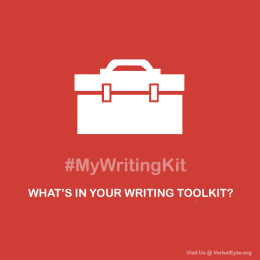 Today I’m sharing some amazing tools as part of Verbaleyze’s My Writing Toolkit event, in hopes you might find some new weapons in the battle for strong, compelling description.
Today I’m sharing some amazing tools as part of Verbaleyze’s My Writing Toolkit event, in hopes you might find some new weapons in the battle for strong, compelling description.
For those not familiar with VerbalEyze, they are a 501(c)3 nonprofit that serves to foster, promote, and support the development and professional growth of emerging young adult writers. How awesome is that?
So if you’re age 13 to 22, you really should look into how Verbaleyze can help you develop your writing.
And if you want to see some amazing writing tools this month, follow the #MyWritingKit hashtag. They have a terrific contest on right now, and both Writers Helping Writers and One Stop For Writers are sponsoring prizes. Stop in and enter, if you like.
Okay, onto my Tool Kit. I hope you like the resources I’ve put together. 
September 6, 2016
How to Stay Organized During a Revision
Hi, everyone! Becca and I are back from our break and ready to rumble. We spent the week visiting with relatives, hosting dinner parties, catching up on the many projects that there’s never enough time for, and I managed to create a bunch of new nifty writing checklists.
(Watch for those in a coming post, or visit this insanely helpful Pinterest board if you just can’t wait!)
 Today however, we have author and writing coach Janice Hardy (@Janice_Hardy) here with some terrific revision advice, so please read on:
Today however, we have author and writing coach Janice Hardy (@Janice_Hardy) here with some terrific revision advice, so please read on:
Revising your novel can be a huge undertaking, and like any large project, going into it prepared can save you time and frustration. It can also help you complete that project in the most efficient and effective way.
How much feedback your manuscript gets before you start revising determines how much you have to keep track of. Detailed critiques from ten beta readers yields a lot more information than a first draft with no outside comments. Keeping track of it all can be challenging, but totally doable.
Step One: Gather Your Materials
Some writers like index cards and tape flags, others use three-ring binders and highlighters, and still others use software with electronic files instead of manila folders. Don’t forget about the non-writing essentials—your favorite drink or snack, reference guides, links to blog posts with great advice (such as Writers Helping Writers or my own site, Fiction University). If you think you’ll need it, put it within reach.
If you don’t have a preferred method yet, try these options:
Software: Collect all your notes and critiques in one file (or folder) in your favorite program. Microsoft Word’s Document Map feature is a handy way to create a table of contents to scan for what you want. Scrivener allows you to add extra text subfiles with everything you need right there per scene or chapter. Note-taking software keeps everything in one place, such as Microsoft’s OneNote or Evernote.
Three-ring binders and paper: For those who prefer a more hands-on approach, a binder can be the perfect fit. You can easily add and move pages as needed, and take notes anywhere. You might even have a separate binder for the manuscript itself, with notes and ideas written on the pages.
Tape flags and printed pages: Print out your manuscript and use different colored tape flags for different aspects of the revision. Tape additional sheets of paper to pages for extra notes, or write on the backs of the manuscript pages. Don’t forget scissors and tape if you go this route. Highlighters and colored pens are also useful.
Step Two: Gather Your Notes
Hunting through files for the feedback you want to address can be both time consuming and annoying. Collect everything in one place so you can easily access it when you reach that section of the revision. Create a story bible with important details to maintain consistency.
Put the notes into the manuscript file: Copy all the comments you want to address directly into the manuscript, so as you read through each scene, you’ll see what needs to be done. Add macro comments to the start of each chapter or scene, or in the beginning of the file. If you have multiple critiquers, you might use a different color per person or type of problem to address.
Create a master revision file: A master file with a summary and list of what you want to revise can provide a nice, step-by-step guide to follow—and a checklist to cross off when that aspect is done.
Print everything out: Hard copies could be a better option for those who prefer to edit from paper.
Use index cards: A popular organization method is to write out what needs to be done per scene on a index card, referencing page numbers or chapters. Put everything on one card, or use different color cards for different characters or options.
Step Three: Gather Your Thoughts
It’s not uncommon to try to tackle too much too fast, and end up frustrated and feeling like you’re not getting anywhere (or worse—that you’re just ruining the manuscript). Take the time you need to be in the right frame of mind to revise your novel and have fun with it.
There’s often a lot to keep track of during revisions, and a little planning before you dive in can make the entire process go more smoothly.
How do you prep for a revision? Do you prepare or dive in?
Win a 10-Page Critique From Janice Hardy
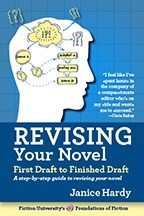 To celebrate the release of my newest writing books, I’m going on a three-month blog tour–and each month, one lucky winner will receive a 10-page critique from me.
To celebrate the release of my newest writing books, I’m going on a three-month blog tour–and each month, one lucky winner will receive a 10-page critique from me.
It’s easy to enter. Simply visit leave a comment and enter the drawing via Rafflecopter. At the end of each month, I’ll randomly choose a winner.
a Rafflecopter giveaway
Looking for tips on revising your novel? Check out my new book Revising Your Novel: First Draft to Finished Draft , a series of self-guided workshops that help you revise your manuscript into a finished novel. Still working on your idea? Then try my just-released Planning Your Novel Workbook .
Janice Hardy is the award-winning author of The Healing Wars trilogy and the Foundations of Fiction series, including Planning Your Novel: Ideas and Structure, a self-guided workshop for planning or revising a novel, the companion Planning Your Novel Workbook, Revising Your Novel: First Draft to Finished Draft and the upcoming Understanding Show, Don’t Tell (And Really Getting It). She’s also the founder of the writing site, Fiction University.
Website | Facebook | Twitter | Goodreads | Amazon | Barnes & Noble | iTunes | Indie Bound
*Excerpted from Revising Your Novel: First Draft to Finished Draft
Save
Save
Save
Save
Save
The post How to Stay Organized During a Revision appeared first on WRITERS HELPING WRITERS®.
August 29, 2016
A Short Blog Break
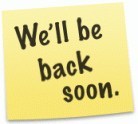 Courtesy: Marco Paköeningrat @ Creative Commons
Courtesy: Marco Paköeningrat @ Creative CommonsWell, August is wrapping up, taking summer and my days of sleeping in, lazing around, and relaxing with it. Boohoo. On the other hand, the kids are going back to school this week, and while I love my kids and the family fun time that summer brings, it is SO time for them to go back to school.
Every year during summer, Ange and I take a blog break. This year, we’ve decided to schedule it at the tail end of things so we can gear up for fall and everything we’ve got going. We have a lot of cool stuff planned for the next six months, both for One Stop and in the book department, and we can’t wait to get started on them. But first, we’re taking a week off to recharge, so we can come back amped up and ready to dive back into writing and work.
So don’t be alarmed by the radio silence. It’s definitely temporary. We’ll be back on September 6th, blowing up your feeds with our regularly scheduled awesomeness ;).
The post A Short Blog Break appeared first on WRITERS HELPING WRITERS®.
August 27, 2016
Emotional Wound Entry: Being Bullied
When you’re writing a character, it’s important to know why she is the way she is. Knowing her backstory is important to achieving this end, and one of the most impactful pieces of a character’s backstory is her emotional wound. This negative experience from the past is so intense that a character will go to great lengths to avoid experiencing that kind of pain and negative emotion again. As a result, certain behaviors, beliefs, and character traits will emerge.
 Characters, like real people, are unique, and will respond to wounding events differently. The vast array of possible emotional wounds combined with each character’s personality gives you many options in terms of how your character will turn out. With the right amount of exploration, you should be able to come up with a character whose past appropriately affects her present, resulting in a realistic character that will ring true with readers. Understanding what wounds a protagonist bears will also help you plot out her arc, creating a compelling journey of change that will satisfy readers.
Characters, like real people, are unique, and will respond to wounding events differently. The vast array of possible emotional wounds combined with each character’s personality gives you many options in terms of how your character will turn out. With the right amount of exploration, you should be able to come up with a character whose past appropriately affects her present, resulting in a realistic character that will ring true with readers. Understanding what wounds a protagonist bears will also help you plot out her arc, creating a compelling journey of change that will satisfy readers.
NOTE: We realize that sometimes a wound we profile may have personal meaning, stirring up the past for some of our readers. It is not our intent to create emotional turmoil. Please know that we research each wounding topic carefully to treat it with the utmost respect.
BEING BULLIED
Examples:
demanding parents or relatives who push “for one’s own good”
siblings that have power or authority (older or larger, big personalities, etc.)
a classmate who takes aim
a group that packs up (a subset of classmates such as members of a sports team, for example)
a teacher or another person in a position of authority
co-workers who are threatened by one’s status or prowess
petty people who use whatever hold they can to take the power of others away
employers
well-connected or wealthy individuals used to getting what they want
Basic Needs Often Compromised By This Wound: physiological needs, safety and security, love and belonging, esteem and recognition, self-actualization
False Beliefs That May Be Embraced As a Result of This Wound:
I deserve this
I am defective
This pain will never end unless I end it
There are no good people in this world
The system (school, government, company policy, parental fairness, whichever applies) is a joke
Everyone hates me
If I died, no one would care or miss me
My life will never get better; happy ever after is for other people
I am a failure and will never succeed at anything
My dreams will never be more than that, dreams
If I let anyone get close they will only hurt me
To show I’m not weak I have to fight
To stop being hurt I have to hurt first
Positive Attributes That May Result: affectionate, alert, analytical, appreciative, cautious, cooperative, courageous, diplomatic, disciplined, efficient, empathetic, generous, honorable, humble, imaginative, independent, industrious, intelligent, introverted, just, kind, loyal, mature, nature-focused, nurturing, obedient, observant, organized, pensive, perceptive, persistent, private, proactive, proper, protective, resourceful, responsible, sentimental, socially aware, wise
Negative Traits That May Result: abrasive, addictive, antisocial, callous, confrontational, cowardly, cruel, cynical, defensive, dishonest, disrespectful, evasive, gullible, hostile, humorless, hypocritical, impulsive, inhibited, insecure, jealous, manipulative, morbid, needy, nervous, oversensitive, paranoid, perfectionist, rebellious, reckless, resentful, self-destructive, subservient, suspicious, temperamental, uncommunicative, vindictive, violent, withdrawn, workaholic, worrywart
Resulting Fears:
fear of relationships (trust issues)
fear of being alone
fear of being in the presence of the bully
fear of violence and pain
fears associated with the bullying (public speaking if one stutters and is bullied for it, a fear of enclosed spaces if one was locked in a closet as punishment or for entertainment, etc.)
fear of a location (school for example, if this is where the bullying takes place)
fear of being on display or ridiculed
fear of social media (if bullying is cyber)
fear of social events (or family events if bullying is within the family)
Possible Habits That May Emerge:
being late (as a result of it being difficult to get up and face the day ahead)
avoiding social events, especially those tied to a common location for bullying (e.g. office parties if the workplace is involved)
finding a safe place to be alone during lunch hours and idle periods
not making eye contact or engaging others in conversation
agreeing in hopes the situation won’t escalate or devolve into a humiliating situation
pretending one is fine (even lying) to loved ones so they don’t worry
pulling back from relationships to avoid letting people in and then being hurt
overreacting and sensitivity; feeling deeply wounded even by the smallest slight when it involves someone one trusts
laughing off slights or smaller humiliations in hopes of nipping the situation in the bud
befriending animals or seeking out solace in nature
daydreaming and escapism (books, TV, movies, video games)
self-medicating
surrounding oneself with positive quotes, reminding oneself that nothing is permanent, trying to boost oneself up to find the strength to face everyday situations
being meticulous with one’s appearance to try and fit in
watching others to see how they behave and trying to emulate them to somehow change and avoid the bullying loop
journalling to get one’s feelings out
crying
self-mutilation (cutting and other self-destructive behaviors)
thoughts of suicide and recklessness, almost to tempt fate
difficulty eating and sleeping; not taking care of oneself
snapping or lashing out at others who are “weaker,” even bullying others in turn for release
TIP: If you need help understanding the impact of these factors, please read our introductory post on the Emotional Wound Thesaurus. For our current list of Emotional Wound Entries, go here.
For other Descriptive Thesaurus Collections, go here.
Image: wokandapix @ pixabay
Save
The post Emotional Wound Entry: Being Bullied appeared first on WRITERS HELPING WRITERS®.
August 25, 2016
The One Stop For Writers® Library Is Evolving
Hi everyone! I haven’t posted an update regarding One Stop For Writers® for some time, so thought I’d do one now. For those of you who don’t know about this little adventure, One Stop For Writers is a one-of-a-kind online library created by Becca, Lee Powell of Scrivener, and me, where we’re doing our best to answer the question, How can we make life easier for writers?
 Hard to believe, but we’re heading towards the end of our first year, and it’s been a great ride so far. We have eleven massive descriptive thesaurus collections, (which will become 13 in coming months), a generator that’s a writer’s dream, templates & worksheets, story maps which lead writers through 6-stage plot structure for 3 different types of character arcs, tutorials…and so much more.
Hard to believe, but we’re heading towards the end of our first year, and it’s been a great ride so far. We have eleven massive descriptive thesaurus collections, (which will become 13 in coming months), a generator that’s a writer’s dream, templates & worksheets, story maps which lead writers through 6-stage plot structure for 3 different types of character arcs, tutorials…and so much more.
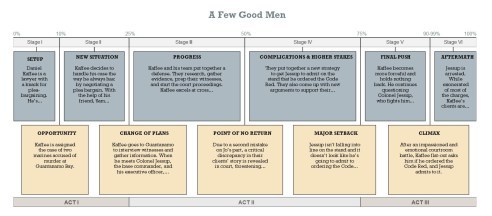 Soon we will also have scene mapping and timeline tools, a world building tool, and a whole new batch of writing lessons that will really help writers deepen their craft.
Soon we will also have scene mapping and timeline tools, a world building tool, and a whole new batch of writing lessons that will really help writers deepen their craft.
Full disclosure: I love working with Lee and Becca, because they work hard, have brilliantly creative minds, and are always on point when it comes to what writers need most. And what’s one of the biggest needs we all have? More time. I mean, do you ever have enough time to write? I don’t. So every precious moment we do get to sit down with our story is really best spent actually writing, right?
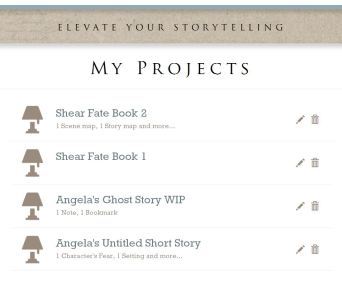 To that end, we’ve made some site changes to create better organization, revamping One Stop so that each of our wordsmiths has a special corner of the library to call their own.
To that end, we’ve made some site changes to create better organization, revamping One Stop so that each of our wordsmiths has a special corner of the library to call their own.
My Workspace is a creativity center where writers can create, save, and collect worksheets, notes, story maps, and bookmarked thesaurus entries to be assigned to individual Projects. These projects act like virtual folders, a perfect storage space for brainstorming materials that go with a novel, short story, or other WIP. Having it all in one place saves you a treasure hunt every time you sit down to write. Like I said, it’s about making sure writers are spending their time writing, not tracking things down. 
August 22, 2016
Creating Mood In A Scene Using Light and Shadow
What’s one of the first things a person does to set the mood at home for a romantic evening? She turns down the lights. This simple adjustment is a big step toward creating a calm, receptive atmosphere. Just as the amount and quality of lighting will influence the way people feel in real life, we can adjust the mood for both characters and readers in our stories by playing with light and shadow.
Most everyone has familiar places that they’ve visited in daylight. But enter that same place at night and it becomes unfamiliar, with a totally different feel. By changing the amount and quality of light in a given place, you can shift the mood without changing the setting. For example, consider an example from a classic, L. M. Montgomery’s description of Birch Path, a recurring location in her Anne of Green Gables series:
 It was a little narrow, twisting path, winding down over a long hill straight through Mr. Bell’s woods, where the light came down sifted through so many emerald screens that it was as flawless as the heart of a diamond.
It was a little narrow, twisting path, winding down over a long hill straight through Mr. Bell’s woods, where the light came down sifted through so many emerald screens that it was as flawless as the heart of a diamond.
One can easily envision this scene under the trees. The green-tinged sunlight gives the scene a lighthearted, cheerful feel, and though the season isn’t mentioned, late spring or summer is inferred, simply by referencing the light.
But the same path traveled later in the day by a character in another frame of mind can look and feel vastly different. Here is Birch Path again, traveled by a more mature Anne in the third book of the series:
 Anne felt lonelier than ever as she walked home, going by way of the Birch Path and Willowmere. She had not walked that way for many moons. It was a darkly-purple bloomy night. The air was heavy with blossom fragrance—almost too heavy.
Anne felt lonelier than ever as she walked home, going by way of the Birch Path and Willowmere. She had not walked that way for many moons. It was a darkly-purple bloomy night. The air was heavy with blossom fragrance—almost too heavy.
The darkly-purple light, combined with Anne’s loneliness and the cloying odors, give the scene a heavy, melancholy feel that wasn’t there before.
(Do keep in mind this example is sourced from a classic, and when writing for a modern audience, we’d need to be careful about wandering too far down the flowery language path–pun intentional!)
Because light and shadow lies within the realm of universal symbolism, people tend to respond to light in a feral way: well-lit areas are deemed safer, putting us at ease, while darker spots have more weight and feel heavier both on the body and the spirit. When setting the mood for a scene, carefully consider the lighting. How much light is there? Where does it come from? Is it hard or soft, comforting or blinding? Is it constant and totally revealing, or does it allow for shadows and hidden places? Questions like these will serve as a guide for how to light a scene in order to set the desired mood.
Keep in mind however that light and shadow may represent something entirely different if one has taken the time to set up personal symbolism. Light itself may represent pain, exposure, risk, or danger to a character who lives safely below ground, or by the necessity of survival, is only able to come out at night. One needs only to look at vampire, werewolf, and demon fiction to see this played out within a story.
TIP: Should you adapt the universal symbolism of light and shadow to something personal which fits the personality of your point of view character or the reality of the world upon which the story is built, make sure to set this up so the meaning is always clear to readers.
Want more ideas on how to set the mood? Save this checklist to Pinterest.

Becca and I have a love affair with powerful description, the kind that does so much more than paints a picture for readers. Creating Mood is only one of ways setting can make your scenes rich and more meaningful.
If you’d like to find out how to also use it to characterize the story’s cast, reveal critical backstory naturally and effectively, steer the plot, reinforce emotion, provide tension & conflict, poke at your protagonist’s emotional wounds…and gosh, SO MUCH MORE, we hope you’ll check out our new Urban Setting and Rural Setting Thesaurus books. 
August 20, 2016
Emotional Wounds Entry: Rejection By One’s Peers
When you’re writing a character, it’s important to know why she is the way she is. Knowing her backstory is important to achieving this end, and one of the most impactful pieces of a character’s backstory is her emotional wound. This negative experience from the past is so intense that a character will go to great lengths to avoid experiencing that kind of pain and negative emotion again. As a result, certain behaviors, beliefs, and character traits will emerge.
Characters, like real people, are unique, and will respond to wounding events differently. The vast array of possible emotional wounds combined with each character’s personality gives you many options in terms of how your character will turn out. With the right amount of exploration, you should be able to come up with a character whose past appropriately affects her present, resulting in a realistic character that will ring true with readers. Understanding what wounds a protagonist bears will also help you plot out her arc, creating a compelling journey of change that will satisfy readers.
NOTE: We realize that sometimes a wound we profile may have personal meaning, stirring up the past for some of our readers. It is not our intent to create emotional turmoil. Please know that we research each wounding topic carefully to treat it with the utmost respect.
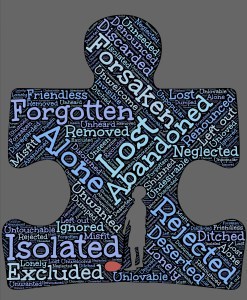
Courtesy: Pixabay
Examples: Being rejected by one’s peers for an unfair reason, such as
one’s race
one’s religion
one’s sexual orientation or gender identity
living in the wrong neighborhood
being poor or homeless
having a parent or caregiver who is despised in some way (for being in jail, being a known philanderer, being a con artist, etc.)
being compared to a notorious sibling
embracing beliefs that go against the popular norm
a physical disfigurement that sets one apart (being an albino, missing limbs, having severe acne or extreme birthmarks, being morbidly obese, etc.)
physically resembling a disreputable figure (Hitler, Charles Manson, a known sex offender, etc.)
a publicly humiliating event from one’s past (wetting one’s pants, being publicly targeted by bullies, etc.)
perceived weakness
social awkwardness
mental deficiency
being considered substandard in intelligence, athletic prowess, social graces, or some other random factor
liking things that are considered weird, taboo, or juvenile
Basic Needs Often Compromised By This Wound: physiological needs, safety and security, love and belonging, esteem and recognition, self-actualization
False Beliefs That May Be Embraced As a Result of This Wound:
I’ll never find love or acceptance.
No one will ever be able to get past X to see the real me.
I don’t need anyone else to get by.
I’m happier on my own.
Maybe they’re all right about me.
Getting back at them will balance the scales.
This is as good as things are going to get.
If I prove my worth in some way, they’ll accept me.
I’m worthless.
I’m ugly/stupid/etc.
Positive Attributes That May Result: cautious, cooperative, courteous, creative, disciplined, discreet, empathetic, focused, funny, generous, independent, industrious, kind, loyal, merciful, nurturing, observant, pensive, persistent, private, quirky, resourceful, simple, studious, supportive
Negative Traits That May Result: antisocial, apathetic, callous, compulsive, cowardly, cruel, dishonest, evasive, frivolous, hostile, humorless, inhibited, insecure, irrational, jealous, macho, manipulative, needy, nervous, oversensitive, perfectionist, pessimistic, rebellious, resentful, self-destructive, subservient, timid, uncommunicative, vindictive, volatile, weak-willed, withdrawn, worrywart
Resulting Fears:
fear of rejection
fear of opening up/being vulnerable to others
fear of people discovering a secret one has been hiding
fear of getting close to others
fear of the kind of person one was rejected by (women, jocks, popular girls, etc.)
Possible Habits That May Emerge:
Withdrawing from others
Seeking out other disenfranchised people and groups
Allowing oneself to be mistreated so one can be part of a group
Giving up the habits, hobbies, or beliefs that one is being persecuted for embracing
Hiding the thing that causes one to be mistreated
An inability to trust others
Suspicion of anyone who reaches out
Distancing oneself from friends who might be contributing to one’s social alienation
Belittling oneself to make others laugh and gain temporary acceptance
Losing one’s identity in an effort to become what is acceptable to others
Giving in to peer pressure
Self-medicating or cutting
Becoming depressed or overly anxious
Becoming physically aggressive
Becoming emotionally volatile
Pursuing tasks that one believes will result in acceptance by one’s peers
Choosing isolating activities that allow one to be alone
Throwing oneself into work, school, or other activities where one feels safe or secure
Low self-esteem
Difficulty trusting others
TIP: If you need help understanding the impact of these factors, please read our introductory post on the Emotional Wound Thesaurus. For our current list of Emotional Wound Entries, go here.
For other Descriptive Thesaurus Collections, go here.
The post Emotional Wounds Entry: Rejection By One’s Peers appeared first on WRITERS HELPING WRITERS®.
August 16, 2016
The Most Neglected Resource for Reviews: YouTube
As authors, we’re constantly looking for more and better ways to gain visibility for our books. This is why I was so excited when Andy Peloquin contacted us about a review possibility that I didn’t know existed. Because it might be news for you, too, I’ve asked him to our blog today to give us the particulars.
For most authors, the majority of our time is spent trying to find ways to sell more books. Author interviews, promo blitzes, and Facebook Party takeovers—there are so many ways to get the word out. But we all know that when it comes to gaining new readers and getting them to buy our books, one of the most important factors is the reviews.
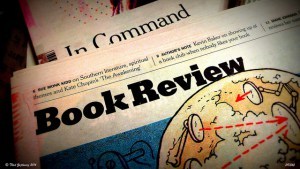
Courtesy: Thad Zajdowicz @ Creative Commons
Book reviews are key because they tell readers and potential buyers what to expect. They’re the unofficial rating that serves as the thumbs up or down. Because of their importance, there are literally THOUSANDS of book review websites, directories, and blogs out there—many of which are flooded with requests from authors. Reviewers often can’t keep up with all the requests they receive, so they’re stuck choosing only books that grab their interest, meaning other books (possibly YOUR book) are going to be sent to the “hopefully sometime in the future” or the “I just don’t have time” piles.
But I’m here to tell you about a review resource that few authors know exists: YouTube. Here are some stats you might not know:
1 billion people use YouTube
There are 4 billion video views on YouTube per day

6 billion hours of video are watched every month
300 new hours of video are uploaded to YouTube every minute
People will spend an average of 40 minutes on YouTube
But here’s the real kicker: less than 9% of small businesses (yes, authors fall into that mix) use this platform for marketing. Which is sad, since YouTube has a great marketing tool for authors that most aren’t aware of in the form of Book Reviewers.
YouTube book reviewers aren’t as common as book bloggers or review websites; the reason for this is that it’s hard to make book reviews interesting when they’re being filmed on video, so it takes a special type of person to do this well. There are a handful of YouTube channels dedicated specifically to book reviews, and while they receive plenty of requests, they get nowhere near as many as the more popular review sites. This means your book has a much higher chance of getting accepted for review.
How do you pick a book review channel? The best option is to visit the channels (see the list at the end of this post) and scroll through each reviewer’s videos to see if they read books like yours; this will narrow down your options to the most likely candidates. You also should check out their submission guidelines to make sure they accept your type of book. You can submit to as many review sites as possible, but if your time is limited and you only want to try the higher profile channels, check out their subscription stats and number of views; this data is often listed on the About page.
How should you submit your books for review? Each channel has its own guidelines on the kinds of books they accept, how to submit, etc. For example, Mercy at Mercy’s Bookish Musings asks you to simply email her with your book details. You can do this for Ariel Bissett, too, but only if your book is traditionally published.
To find out how to submit and what is/isn’t accepted for a given reviewer, simply visit that YouTube channel’s About page. There, you’ll find the submission email address and other necessary information—similar to the way you’d submit to any website or book blog.
What if your book is accepted? How can you capitalize on a good YouTube review? You can tell the world about it. Link to it on all your social media sites, blog about the review, embed it on your personal bookstore page, post it on your Goodreads author profile or Amazon Author Central page—there are so many ways to let existing and potential buyers know that your book has been well received. And the good news is that nearly every site is compatible with YouTube, so the process is fairly simple.
Where do I find these channels? I’m so glad you asked! Here’s a sample listing of book review channels that can be found on YouTube:
https://www.youtube.com/user/MercysBookishMusings/about
https://www.youtube.com/c/arielbissett/about
https://www.youtube.com/c/bazpierce/about
https://www.youtube.com/user/abookutopia/about
https://www.youtube.com/c/hailsheartsnyc/about
https://www.youtube.com/user/booksbetterthanfood/about
https://www.youtube.com/c/booksandquills/about
https://www.youtube.com/user/missloopylouful/about
https://www.youtube.com/c/peruseproject/about
https://www.youtube.com/c/jessethereader/about
https://www.youtube.com/c/polandbananasbooks/about (likes Throne of Glass–ergo, dark fantasy)
https://www.youtube.com/c/jeanmbt/about
https://www.youtube.com/c/impressionblendofficial/about
https://www.youtube.com/c/chapterstackss/about
https://www.youtube.com/c/ashleybbooks/about
https://www.youtube.com/c/pimpbookreviews/about
https://www.youtube.com/c/lovingdembooks/about
https://www.youtube.com/c/thereadables/about
https://www.youtube.com/c/unboundbookreviews/feed
https://www.youtube.com/user/bookwormstalk/about
These are just 20 of the channels that do reviews, but there are many more (I’ve found close to 50). You can find them for yourself by searching for “Book Reviews” on YouTube, or drop me a line at andy.peloquin@gmail.com and I’d be happy to send over the rest of my list. Best of luck!
 Andy Peloquin–a third culture kid to the core–has loved to read since before he could remember. Sherlock Holmes, the Phantom of the Opera, and Father Brown are just a few of the books that ensnared his imagination as a child. When he discovered science fiction and fantasy through the pages of writers like Edgar Rice Burroughs, J.R.R Tolkien, and Orson Scott Card, he was immediately hooked and hasn’t looked back since. Reading—and now writing—is his favorite escape, and it provides him an outlet for his innate creativity. He is an artist; words are his palette.
Andy Peloquin–a third culture kid to the core–has loved to read since before he could remember. Sherlock Holmes, the Phantom of the Opera, and Father Brown are just a few of the books that ensnared his imagination as a child. When he discovered science fiction and fantasy through the pages of writers like Edgar Rice Burroughs, J.R.R Tolkien, and Orson Scott Card, he was immediately hooked and hasn’t looked back since. Reading—and now writing—is his favorite escape, and it provides him an outlet for his innate creativity. He is an artist; words are his palette.
His website is a second home for him, a place where he can post his thoughts and feelings–along with reviews of books he finds laying around the internet. He can also be found on Facebook and Twitter.
The post The Most Neglected Resource for Reviews: YouTube appeared first on WRITERS HELPING WRITERS®.
August 13, 2016
Emotional Wound Entry: Being So Beautiful It’s All People See
When you’re writing a character, it’s important to know why she is the way she is. Knowing her backstory is important to achieving this end, and one of the most impactful pieces of a character’s backstory is her emotional wound. This negative experience from the past is so intense that a character will go to great lengths to avoid experiencing that kind of pain and negative emotion again. As a result, certain behaviors, beliefs, and character traits will emerge.
 Characters, like real people, are unique, and will respond to wounding events differently. The vast array of possible emotional wounds combined with each character’s personality gives you many options in terms of how your character will turn out. With the right amount of exploration, you should be able to come up with a character whose past appropriately affects her present, resulting in a realistic character that will ring true with readers. Understanding what wounds a protagonist bears will also help you plot out her arc, creating a compelling journey of change that will satisfy readers.
Characters, like real people, are unique, and will respond to wounding events differently. The vast array of possible emotional wounds combined with each character’s personality gives you many options in terms of how your character will turn out. With the right amount of exploration, you should be able to come up with a character whose past appropriately affects her present, resulting in a realistic character that will ring true with readers. Understanding what wounds a protagonist bears will also help you plot out her arc, creating a compelling journey of change that will satisfy readers.
Being So Beautiful It’s All People See
NOTE: We realize that sometimes a wound we profile may have personal meaning, stirring up the past for some of our readers. It is not our intent to create emotional turmoil. Please know that we research each wounding topic carefully to treat it with the utmost respect.
Basic Needs Often Compromised By This Wound: safety and security, love and belonging, esteem and recognition, self-actualization
False Beliefs That May Be Embraced As a Result of This Wound:
my only worth is in my looks
I will never be respected for my hard work, brains, or skills
people only want to be close because of how I look and what my beauty can do for them
no one really cares what I think or believe in
everyone believes my life is wonderful no matter what I tell them
being beautiful is what matters; without it I am nothing
no one knows (or cares) who I really am
I can only be what others want me to be, not live for myself
I must choose a career in the beauty industry because it’s expected
Many of my (same-sex) friends secretly hate me
I can’t have deep friendships with members of the opposite sex because I am only a sex object to them
I have to keep personal pain/hardships to myself because people will just believe I’m attention-seeking or narcissistic
Positive Attributes That May Result: cautious, charming, courteous, cooperative, disciplined, easygoing, extroverted, flirtatious, friendly, generous, gentle. honorable, idealistic, introverted, loyal, kind, mature, obedient, organized, perceptive, persuasive, playful, private, proactive, protective, sensual, sophisticated, uninhibited, unselfish, whimsical
Negative Traits That May Result: abrasive, addictive, catty, childish, cocky, cynical, defensive, dishonest, extravagant, flaky, frivolous, gossipy, haughty, hypocritical, impatient, impulsive, inhibited, insecure, jealous, judgemental, lazy, macho, manipulative, materialistic, melodramatic, pretentious, promiscuous, rebellious, reckless, self-destructive, self-indulgent, spoiled, subservient, temperamental, vain, withdrawn, workaholic
Resulting Fears:
fear of stalking, violence, and sexual assault (especially women)
fear of being taken advantage of
fear of being trapped by one’s own beauty (life choices, career, opportunities)
fear of aging or losing one’s beauty
fear of illness and disease
trust issues–fear of trusting the wrong person
fear of retribution or sabotage via a jealous peer
Possible Habits That May Emerge:
meticulous health and beauty regimes
dieting and working out
questioning and second guessing one’s choices (a deep need for approval or fitting in)
people-pleasing
avoiding close relationships (over doubt as to if they are “real” or not)
not complaining because people will react with a lack of empathy
seeking out activities where beauty doesn’t matter (working at an animal shelter, getting out in nature, sport activities, volunteering for a specific cause)
acting the way people expect to make life easier
being very safety conscious; avoiding dangerous places
working hard to be likeable to negate “primal” resentful feelings with the same-sex
fighting or hiding low self-esteem issues behind smiles/forced confidence
keeping secrets, rarely divulging one’s deepest feelings and desires
depression and engaging in behavior to cope with it (medicating, withdrawing from relationships, choosing to be alone, cutting in areas that won’t been seen, etc.)
TIP: If you need help understanding the impact of these factors, please read our introductory post on the Emotional Wound Thesaurus. For our current list of Emotional Wound Entries, go here.
For other Descriptive Thesaurus Collections, go here.
Image: Alexas_fotos @ Pixabay
Save
The post Emotional Wound Entry: Being So Beautiful It’s All People See appeared first on WRITERS HELPING WRITERS®.
August 9, 2016
Critiques 4 U!
Can you believe it’s August already?? Some of you, I know, are getting ready for the new school year while some of us in the north have a little more summer left. I admit that after living in Florida most of my life, it’s a little weird to not go back to school until September. Not that I’m complaining; my family and I put together a summer bucket list, and we’ve been having a blast doing things like going to a chocolate factory,
visiting the grandparents in Alabama,
and picking our own berries.
I’m not sure we’re going to finish everything in the next few weeks, but we’ll do our best. My kids made up most of the list, and for some reason, critiques didn’t make the cut. But they’re on my own personal list, so
It’s Critiques 4 U Time!
If you’re working on a first page and would like some objective feedback, please leave a comment that includes:
1) your email address. Some of you have expressed concern about making your email address public; if you’re sure that the email address associated with your WordPress account is correct, you don’t have to include it here. But if you do win and I’m unable to contact you through that email address, I’ll have to choose an alternate winner.
2) your story’s genre (no erotica, please)
ONLY ENTRIES THAT FOLLOW THESE INSTRUCTIONS WILL BE CONSIDERED
Three commenters’ names will be randomly drawn and posted tomorrow. If you win, you can email me your first page and I’ll offer my feedback. Best of luck!
The post Critiques 4 U! appeared first on WRITERS HELPING WRITERS®.
Writers Helping Writers
- Angela Ackerman's profile
- 1014 followers






